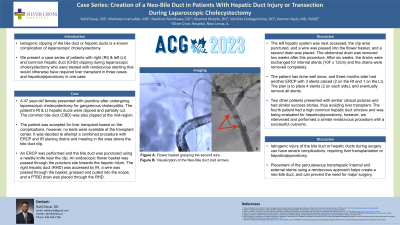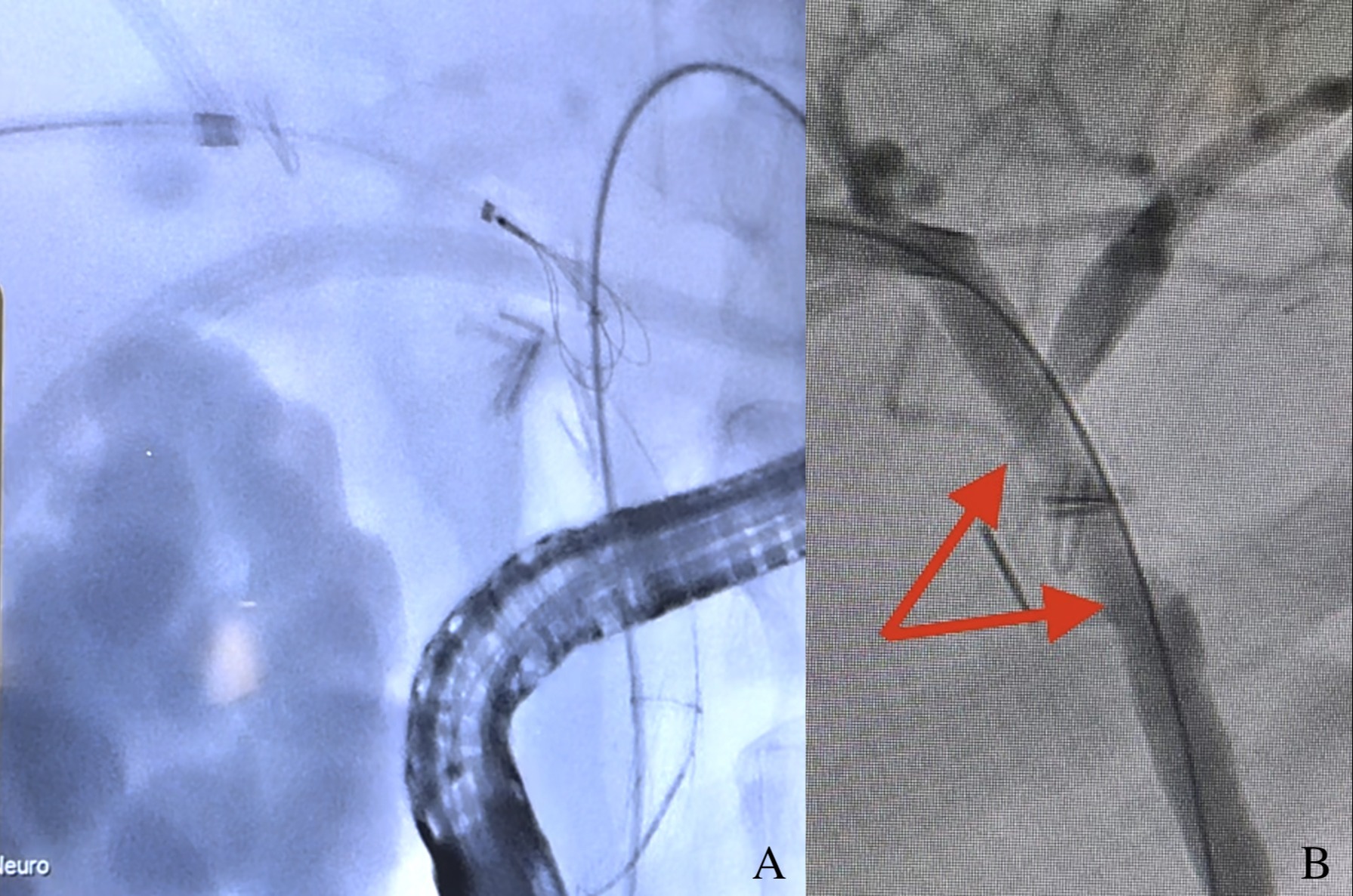Monday Poster Session
Category: Interventional Endoscopy
P2340 - Case Series: Creation of a Neo-Bile Duct in Patients With Hepatic Duct Injury or Transection During Laparoscopic Cholecystectomy
Monday, October 23, 2023
10:30 AM - 4:15 PM PT
Location: Exhibit Hall

Has Audio

Rahil Desai, DO
Franciscan Health Olympia Fields
Westlake, OH
Presenting Author(s)
Award: Presidential Poster Award
Rahil Desai, DO1, Mahnoor Inamullah, MD2, Navkiran Randhawa, DO3, Ahamed Khalyfa, DO4, Varshita Goduguchinta, DO5, Kamran Ayub, MD6
1Franciscan Health Olympia Fields, Westlake, OH; 2Southwest Gastroenterology, a Division of GI Partners of Illinois, Oak Lawn, IL; 3Augusta University, Medical College of Georgia, Dyer, IN; 4University of Iowa, Iowa City, IA; 5Franciscan Health Olympia Fields, Chicago, IL; 6Silver Cross Hospital, New Lenox, IL
Introduction: Iatrogenic clipping of the bile duct or hepatic ducts is a known complication of laparoscopic cholecystectomy. We present a case series of patients with right (Rt) & left (Lt) and common hepatic duct (CHD) clipping during laparoscopic cholecystectomy who were treated with rendezvous stenting that would otherwise have required liver transplant in three cases and hepaticojejunostomy in one case.
Case Description/Methods: A 47 year-old female presented with jaundice after undergoing laparoscopic cholecystectomy for gangrenous cholecystitis. The patient’s Rt & Lt hepatic ducts were clipped and partially cut. The common bile duct (CBD) was also clipped at the mid-region. The patient was accepted for liver transplant based on the complications, however, no beds were available at the transplant center. It was decided to attempt a combined procedure with ERCP and IR placing drains and meeting in the area above the bile duct clip. An ERCP was performed and the bile duct was punctured using a needle knife near the clip. An endoscopic flower basket was passed through the puncture site towards the hepatic hilum. The right hepatic duct (RHD) was accessed by IR, a wire was passed through the basket, grasped and pulled into the scope, and a PTBD drain was placed through the RHD. The left hepatic system was next accessed, the clip area punctured, and a wire was passed into the flower basket, and a second drain was placed. The abdominal drain was removed two weeks after this procedure. After six weeks, the drains were exchanged for internal stents (10F x 12cm) and the drains were removed completely. The patient has done well since, and three months later had another ERCP with 3 stents placed (2 on the Rt and 1 on the Lt). The plan is to place 4 stents (2 on each side), and eventually remove all stents.
Two other patients presented with similar clinical pictures and had similar success stories, thus avoiding liver transplant. The fourth patient had a high common hepatic duct stricture and was being evaluated for hepaticojejunostomy, however, we intervened and performed a similar rendezvous procedure with a successful outcome.
Discussion: Iatrogenic injury of the bile duct or hepatic ducts during surgery can have severe complications, requiring liver transplantation or hepaticojejunostomy. Placement of the percutaneous transhepatic internal and external stents using a rendezvous approach helps create a neo-bile duct, and can prevent the need for major surgery.

Disclosures:
Rahil Desai, DO1, Mahnoor Inamullah, MD2, Navkiran Randhawa, DO3, Ahamed Khalyfa, DO4, Varshita Goduguchinta, DO5, Kamran Ayub, MD6. P2340 - Case Series: Creation of a Neo-Bile Duct in Patients With Hepatic Duct Injury or Transection During Laparoscopic Cholecystectomy, ACG 2023 Annual Scientific Meeting Abstracts. Vancouver, BC, Canada: American College of Gastroenterology.
Rahil Desai, DO1, Mahnoor Inamullah, MD2, Navkiran Randhawa, DO3, Ahamed Khalyfa, DO4, Varshita Goduguchinta, DO5, Kamran Ayub, MD6
1Franciscan Health Olympia Fields, Westlake, OH; 2Southwest Gastroenterology, a Division of GI Partners of Illinois, Oak Lawn, IL; 3Augusta University, Medical College of Georgia, Dyer, IN; 4University of Iowa, Iowa City, IA; 5Franciscan Health Olympia Fields, Chicago, IL; 6Silver Cross Hospital, New Lenox, IL
Introduction: Iatrogenic clipping of the bile duct or hepatic ducts is a known complication of laparoscopic cholecystectomy. We present a case series of patients with right (Rt) & left (Lt) and common hepatic duct (CHD) clipping during laparoscopic cholecystectomy who were treated with rendezvous stenting that would otherwise have required liver transplant in three cases and hepaticojejunostomy in one case.
Case Description/Methods: A 47 year-old female presented with jaundice after undergoing laparoscopic cholecystectomy for gangrenous cholecystitis. The patient’s Rt & Lt hepatic ducts were clipped and partially cut. The common bile duct (CBD) was also clipped at the mid-region. The patient was accepted for liver transplant based on the complications, however, no beds were available at the transplant center. It was decided to attempt a combined procedure with ERCP and IR placing drains and meeting in the area above the bile duct clip. An ERCP was performed and the bile duct was punctured using a needle knife near the clip. An endoscopic flower basket was passed through the puncture site towards the hepatic hilum. The right hepatic duct (RHD) was accessed by IR, a wire was passed through the basket, grasped and pulled into the scope, and a PTBD drain was placed through the RHD. The left hepatic system was next accessed, the clip area punctured, and a wire was passed into the flower basket, and a second drain was placed. The abdominal drain was removed two weeks after this procedure. After six weeks, the drains were exchanged for internal stents (10F x 12cm) and the drains were removed completely. The patient has done well since, and three months later had another ERCP with 3 stents placed (2 on the Rt and 1 on the Lt). The plan is to place 4 stents (2 on each side), and eventually remove all stents.
Two other patients presented with similar clinical pictures and had similar success stories, thus avoiding liver transplant. The fourth patient had a high common hepatic duct stricture and was being evaluated for hepaticojejunostomy, however, we intervened and performed a similar rendezvous procedure with a successful outcome.
Discussion: Iatrogenic injury of the bile duct or hepatic ducts during surgery can have severe complications, requiring liver transplantation or hepaticojejunostomy. Placement of the percutaneous transhepatic internal and external stents using a rendezvous approach helps create a neo-bile duct, and can prevent the need for major surgery.

Figure: Figure A: Flower basket grasping the second wire
Figure B: Visualization of the Neo-Bile duct (red arrows)
Figure B: Visualization of the Neo-Bile duct (red arrows)
Disclosures:
Rahil Desai indicated no relevant financial relationships.
Mahnoor Inamullah indicated no relevant financial relationships.
Navkiran Randhawa indicated no relevant financial relationships.
Ahamed Khalyfa indicated no relevant financial relationships.
Varshita Goduguchinta indicated no relevant financial relationships.
Kamran Ayub indicated no relevant financial relationships.
Rahil Desai, DO1, Mahnoor Inamullah, MD2, Navkiran Randhawa, DO3, Ahamed Khalyfa, DO4, Varshita Goduguchinta, DO5, Kamran Ayub, MD6. P2340 - Case Series: Creation of a Neo-Bile Duct in Patients With Hepatic Duct Injury or Transection During Laparoscopic Cholecystectomy, ACG 2023 Annual Scientific Meeting Abstracts. Vancouver, BC, Canada: American College of Gastroenterology.

